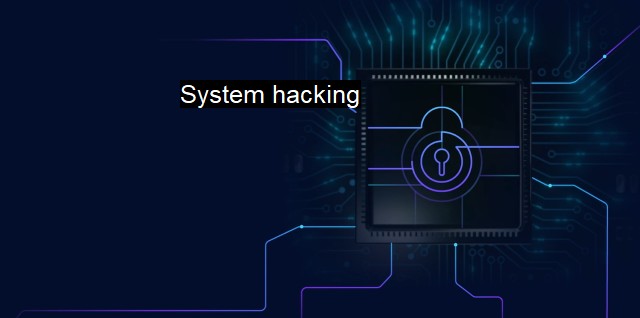What is System hacking?
Exploring the World of System Hacking: Understanding cybersecurity threats and the role of antivirus software
System hacking is often misconstrued due to inaccurate representation in Hollywood movies, where hackers magically manipulate their way into impenetrable systems with a few dynamic keystrokes. Indeed, the reality is more intricate and laborious, less about cinematic flair and more about a deep understanding of computers, networks and various programming languages.System hacking is the practice of infiltrating a computer system or a network either to manipulate its functions or to steal, destroy, or alter the information contained within. Since our world is increasingly becoming digitally interconnected, the concept assumes substantial significance within the realms of cybersecurity and antivirus.
System hacking is typically executed in a succession of stages. The process often commences with the hacker trying to gain access to the target network or system. This stage is known as footprinting and involves an extensive reconnaissance to gather as much information as possible about the target system. It can involve identifying IP addresses, servers, domain names or studying protocols used by the system.
Incidentally, entrance to the system does not even necessarily warrant hacking skills; often times, a novice hacker might instead exploit poor security countenances and user complacency. Leaving passwords at easily accessible locations, or not having strong, mixed-type passwords can give a hacker simple access. Quite noticeably, footprinting exemplifies how social engineering – the art of manipulating humans into disclosing confidential details – can be a potent facet of system hacking.
After the footprinting phase, the hacker then proceeds to scan and enumerate the system to identify potential vulnerabilities that can be exploited. Once these vulnerabilities are identified, they move to the third stage - gaining access to the system. This can be executed through a variety of tactics involving the manipulation of trust-based relationships, back doors, and other strategy exploits.
Once access is gained, maintaining that access is the next objective. Hackers often plant rootkits or backdoors into a system to maintain control or return later. Thus, leading us to diving deeper into cybersecurity and antivirus. Antivirus software is crucial to preventing system hacking attempts. These tools are designed to identify and neutralize threats before they can do any damage. Many modern antiviruses also have defensive protocols against various hacking methods, including phishing, DDoS attacks, and SQL injection, among others.
Addressing system hacking doesn’t end at prevention – it is as crucial to have a robust incident response mechanism in place for when attacks do occur. Efforts need to coordinate the right resources to identify the root causes swiftly, limit the exposure and damage, push necessary patches or compensations and learn from every incursion to ward off potential recurrences.
One of the glaring potential risks of system hacking in our digital age is identity thievery, confidentially exposure, and massive data breaches can generate profound impacts on one's personal or business life. With organizations increasingly digitalizing all aspects of their business, data loss or stolen customer information can cause severe financial and reputational damage.
Cyber-physical systems controlling our power grids, medical devices, and smart city infrastructure extend the risks of system hacking to compromised physical security and impact on human lives. A hacking incident in a critical infrastructure could have nationwide ramifications affecting public faith in the digital transformation.
Consequently, in this age of the Internet and technology, system hacking persists as a menacing phantom haunting both individuals and organizations. It’s essential to understand the steps of a hacking incident – reconnaissance, scanning, gaining access, and maintaining that access – to tackle it effectively. Antivirus software and multilayered security strategies can offer the essential protection needed to counterbalance this significant threat, affirming the importance of cybersecurity.
Delving into the world of cybersecurity presents us with the sober reality of system hacking conundrum confronting us. Flexibility, a keen understanding of the technological landscape, and an unwavering commitment to safeguarding our digital spaces must tooltip our endeavor to restrain this increasing threat of system hacking. Audi alteram partem before you discount the lurking perils that inhabit the web, reminding ourselves of the protective measures, protocols and context-aware security frameworks in place.

System hacking FAQs
What is system hacking?
System hacking is the unauthorized intrusion into a computer system or network with the intention of accessing or modifying sensitive data, disrupting normal operations, or causing harm to the system.How can system hacking be prevented?
System hacking can be prevented by implementing strong and updated antivirus software, using strong passwords, restricting access to sensitive data, and regularly backing up important files.What are the consequences of system hacking?
The consequences of system hacking can include data breaches, financial losses, loss of reputation, legal action, and disruption of operations. It can also lead to unauthorized access to private and sensitive information.What should I do if I suspect that my system has been hacked?
If you suspect that your system has been hacked, immediately disconnect it from the internet and notify your IT department or a cybersecurity professional. Preserve any evidence by taking screenshots or photos of the suspicious activity and avoid using the affected device until it has been thoroughly examined and cleaned up.| | A | | | B | | | C | | | D | | | E | | | F | | | G | | | H | | | I | | | J | | | K | | | L | | | M | |
| | N | | | O | | | P | | | Q | | | R | | | S | | | T | | | U | | | V | | | W | | | X | | | Y | | | Z | |
| | 1 | | | 2 | | | 3 | | | 4 | | | 7 | | | 8 | | |||||||